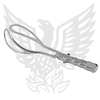Operative Delivery Flashcards
What is valsalva?
It is forced exhalation against a closed airway
Test cardiac function and autonomic control of the heart, or clear ear and sinuses

What are the indications for operative vaginal delivery for:
Nulliparous women
Multiparous women
Nulliparous women - lack of continuing progress for 3 hours with regional anaesthesia; or 2 hours without anaesthesia
Multiparous women - lack of continuing progress for 2 hours with regional anaesthesia; or 1 hour without anaesthesia
What are the requirements for instrumental delivery?
Valid reason
Head not palpable (abdominally)
Head must be at/below level of ischial spines
Cervix dilated
Position of foetal head known
Adequate Analgesia
Bladder empty
Must have facilities to perform C-section in case of failure
What is a ventouse and how is it used?
It is a cap fixed 2-3cm anterior to the posterior fontanelle (flexion point) by suction

What are the names of the rotational and non-rotational forceps?
Non-rotational = Neville-Barnes
Rotational = Kiellands
What is this?

Kiellands forceps - Rotational
What is this?

Neville Barnes - with pelvic curve, non-rotational
What should be used for instrumental delivery when the foetal head is the following positions?
occipito-anterior
occipito-transverse
occipito-posterior
Occipito-anterior: Forceps or Ventouse
Occipito-transverse: Usually due to insufficient dsecent of head to cause rotation
- Ventouse to achieve descent and hopefully rotation
- Rotational forceps to achieve rotation in situ → descent
Occipito-posterior: Often + extension of foetal head → presenting part too large
- Aim for rotation of 180o with ventouse/rotational forceps
Which complications are associated to each method, ventouse and forceps?
Ventouse more dangerous in general, Forceps only more dangerous for perineal and vaginal trauma
Equal likelihood of delivery by C-section, low 5-minute APGAR, need for phototherapy

When is operative vaginal delivery stopped?
- No evidence of progressive descent with each pull
- Delivery is not imminent following three pulls of correctly applied instrument by experienced operator
What proportion of babies are delivered by caesarean section in the developed world?
20-30%
What are the absolute indications for emergency C-section?
Placenta praevia
Severe antenatal fetal compromise
Uncorrectable abnormal lie
Previous classical C-section
Pelvic deformity
What are relative indications for emergency C-section?
Breech presentation
DM and other medical diseases
Previous C-sections
Older nulliparous women
When is an emergency C-section indicated before 34 weeks
Severe pre-ecampsia
Severe intrauterine growth restriction
What type of inscision is made in a C-section?
Pfannesteil incision - horizontal (skin)
Lower segment ceasarean section (uterus)
Other incisions: Vertical (skin), Classical (uterus)


